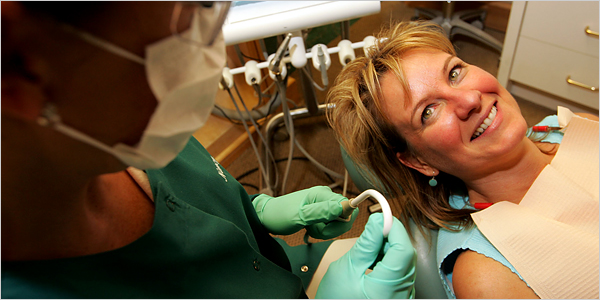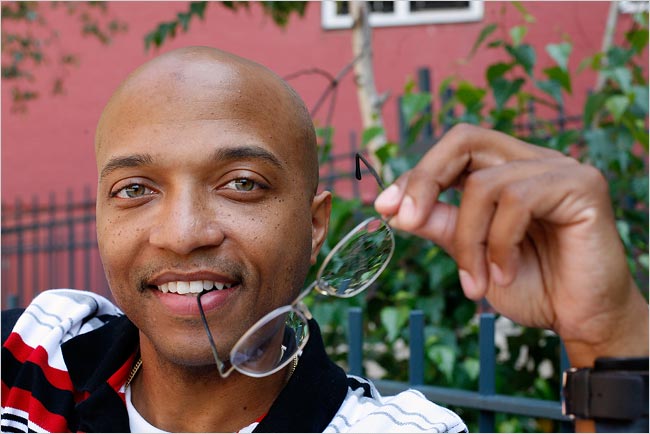| Want to send this page or a link to a friend? Click on mail at the top of this window. |
More Special Reports |
| Posted August 30, 2007 |
| Patients Turn to No-Interest Loans for Health Care |
 |
|
Aaron Houston for The New York Times |
|
| Nancy Schlachter paid for a $6,000 dental bill with an interest-free loan. Banks and insurers are offering more such financing. |
By MILT FREUDENHEIM |
Zero-interest financing, a familiar sales incentive at car dealerships and furniture stores, has found its way to another big-ticket consumer market: doctors’ and dentists’ offices.
For $3,500 laser eye surgery, $6,000 ceramic tooth implants or other procedures not typically covered by insurance, millions of consumers have arranged financing through more than 100,000 doctors and dentists that offer a year or more of interest-free monthly payments.
Of course, going into debt to pay for medical procedures is nothing new for many people. And this type of financing is still only a fraction of the nation’s $900 billion market for consumer revolving credit.
 |
Michael Nagle for The New York Times |
| Derrick Fields has $250 a month deducted from his bank account to pay for his laser eye surgery. |
But as the price of health care continues to rise and big lenders pursue new areas for growth, this type of medical financing has become one of the fastest-growing parts of consumer credit, led by lending giants like Capital One and Citigroup and the CareCredit unit of General Electric.
Big insurers, too, are devising new financing plans with various payback options. Upstart players have also aggressively cut deals with doctors.
The room for expansion looks ample, as rising deductibles, co-payments and other costs may force more of the nation’s 250 million people with health insurance to finance out-of-pocket expenses for even basic medical care.
“As more and more of the costs of care are shifted to consumers, people are going to need more credit,” said Red Gillen, a senior analyst at Celent, an insurance and banking research firm. “They are still going to need health care.”
The zero-interest plans are not for everyone. In fact, they are available only to the creditworthy — meaning they offer no help to those among the nation’s 47 million uninsured who are in difficult financial situations.
And creditworthiness is starting to be judged even more stringently, in light of the subprime mortgage crisis’s impact on the debt markets, according to David Robertson, publisher of The Nilson Report, a newsletter for the credit card industry.
Even for those who can get credit approval, the plans make sense only if users are able to make payments on time and close the loan on schedule, typically within 12 months. Otherwise, the loans after defaults can carry interest rates of 20 percent or more — similar to the default penalty on a typical credit card.
“We are very careful to tell patients upfront, ‘Be sure you can make your payments,’ ” said Dr. Richard J. Mercurio, a dentist in Lincroft, N.J. He arranges patient financing through the CareCredit unit of G.E., the leader in consumer medical financing.
Dr. Mercurio says he knows of at least two patients who missed payments and received monthly bills charging high interest rates. “They were not happy,” he said.
For those who are able to make their payments, though, the plans can make it possible to receive treatments that otherwise might be out of reach.
“There was no way I had $6,000 right out of my pocket,” said Nancy Schlachter, 40, who has dental insurance through her job as an accounts payable manager for a national construction company. She went to Dr. Mercurio for a series of dental procedures including a new crown, fillings and a tooth implant.
“The implant was very expensive, and it was not covered,” Ms. Schlachter said. But the dentist’s office arranged 12-month zero-interest financing. “It was the only way I could do it,” she said.
Some consumer debt experts warn that as more people try to bridge widening gaps in their health insurance, paying for medical care on credit could plunge the unwary into a financial crisis. In recent years, the use of high-interest credit cards to pay big medical bills has become a leading cause of consumer bankruptcy.
“Unless they are at risk of losing life or limb, people should be very cautious about putting medical bills on credit cards,” said Mark Rukavina, executive director of the Access Project, a research and consumer advocacy organization that helps people with their medical debts.
Still, consumer credit companies and some insurers are now experimenting with financing plans meant specifically for medical costs.
For people who think they could not pay off a zero-interest loan within a year, most credit companies also offer longer-term medical financing deals with 12 percent to 13 percent interest payable over several years. Those plans, though, must be arranged at the outset of the medical expense; a zero-interest plan typically cannot be converted to the longer-term program if consumers find themselves unable to pay off the one-year loans.
Some insurers, including UnitedHealthcare, also have special credit plans available for insured members whose policies are linked to health savings accounts. Such policies combine high-deductible insurance with tax-sheltered savings accounts where money can roll over year to year until needed for medical expenses. But typically, the amounts of money being set aside do not go very far toward meeting even routine health expenses.
So far, among the 1.76 million health savings accounts in this country, the average balance is $1,327, according to a recent survey by Inside Consumer-Directed Care, a trade publication. To help people with health savings accounts meet the shortfall, the Exante Bank unit of UnitedHealth Group is trying out a card that extends credit at rates currently averaging about 10 percent to 13 percent, depending on the applicant’s credit history.
UnitedHealthcare is also testing a medical credit card that would offer reduced rates.
“There’s a place for credit solutions that are integrated within traditional health insurance programs, when an individual hits that out-of-pocket expense,” said Tom Beauregard, a senior vice president at UnitedHealthcare. “The key is to make it voluntary, to make it simple and to offer favorable credit terms.”
As for the zero-interest deals, the credit providers say that most of them end up being just that — interest-free. About 80 percent of the medical loans that CareCredit provides are paid off on schedule and incur no finance charges, according to the company’s president, Michael J. Testa.
That, the companies say, justifies the high default interest rates for late payments, since that is the way they recoup the costs of doing business. In fact, though, the credit companies make money even on the interest-free deals, because they are typically keeping 10 percent of the fee the doctor charges the patient. On a $5,000 cosmetic nose operation, for instance, the plastic surgeon might receive only $4,500.
Another of the medical finance companies, HELPcard, says that for dentists whose customers are good credit risks, the lender’s commission might be only 4 percent to 5 percent. But for patients with low credit ratings, a dentist eager to build a clientele might have to accept as little as 75 percent of the bill, said Pat McGee, HELPcard’s senior vice president for sales and marketing.
The CareCredit unit of G.E., too, has special deals for patients whose credit is not well established. Stephanie Waterman, a coordinator for Dello Russo Laser Vision, a laser-surgery practice with offices in New York and Bergenfield, N.J., said patients deemed less creditworthy were required to pay $600 in cash and to agree to have 12 months of zero-interest payments taken directly from their bank accounts.
One Dello Russo patient, Senior Airman Derrick Fields, 31, stationed at Dover Air Force Base in Delaware, said that in June he paid $600 down on a $3,500 surgery bill for both eyes — a reduced charge the practice offers to members of the military.
“They take about $250 a month from my bank account,” said Mr. Fields, who said he soon expected to not wear eyeglasses for the first time since the second grade. “I owe $2,900.”
Copyright 2007 The New York Times Company. Reprinted from The New York Times, Health, of Thursday, August 30, 2007.
| Wehaitians.com, the scholarly journal of democracy and human rights |
| More from wehaitians.com |